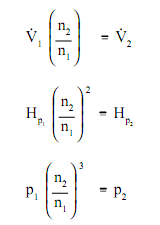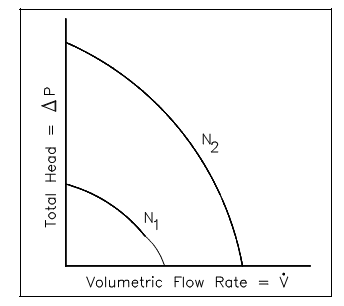Pump Laws
Centrifugal pumps normally follow what are recognized as the pump laws. Such law define that the flow rate or capacity is directly proportional to the pump speed; the discharge head is directly proportional to the square of the pump speed; and the power needed by the pump motor is directly proportional to the cube of the pump speed. Such laws are summarized in the following equations as follows:
V ∝ n
Hp ∝ n 2
p ∝ n 3
Here:
n = speed of pump impeller (rpm)
V = volumetric flow rate of pump (gpm or ft3/hr)
Hp = head developed by pump (psid or feet)
p = pump power (kW)
By using such proportionalities, it is possible to develop equations associating the condition at one speed to those at various speed.

It is probable to develop the characteristic curve for the new speed of a pump depends on the curve for its original speed. The method is to take numerous points on the original curve and exert the pump laws to establish the new head and flow at the new speed. The pump head versus flow rate curve which outcomes from a change in pump speed is graphically illustrated in the figure shown below.

Figure: Changing speeds for centrifugal pump